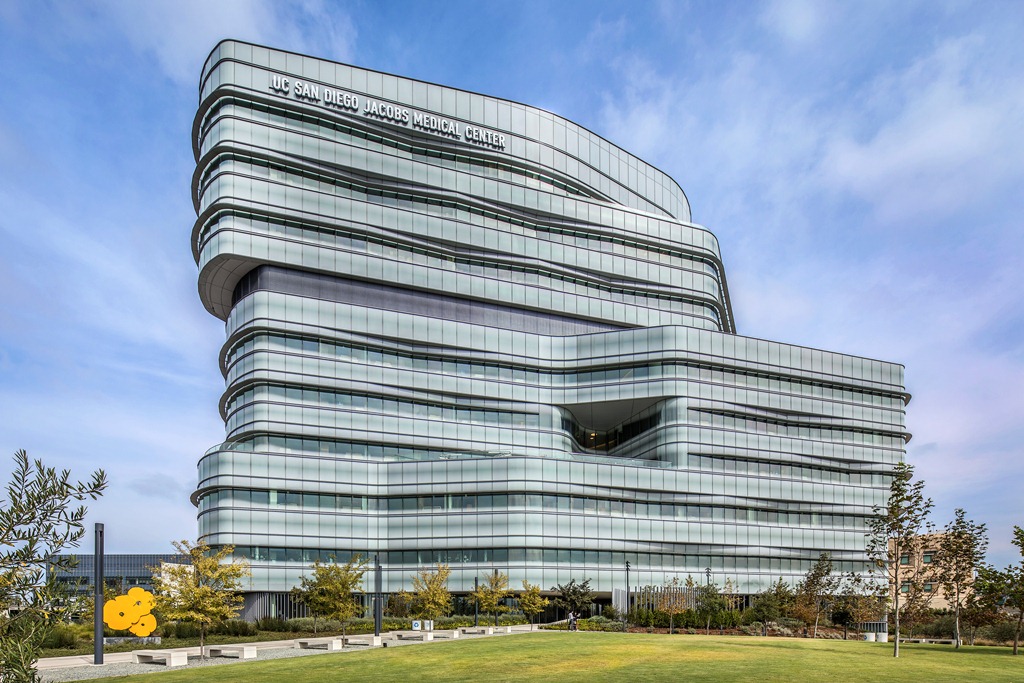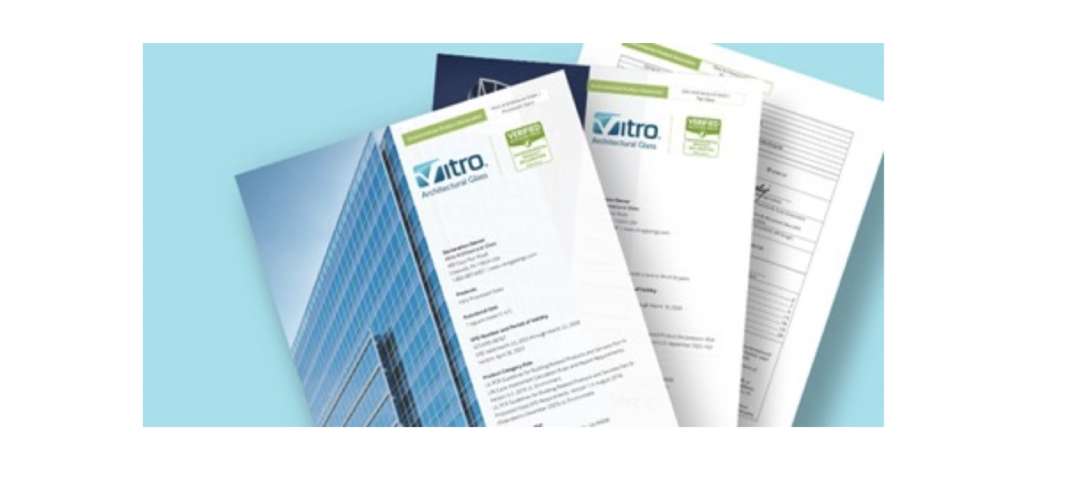Patient-first care is alive and well at Jacobs Medical Center, a 509,000-square-foot, 245-bed medical and surgical specialty hospital that innovatively fuses together modern technology, forward-thinking design and a healing environment. The University of California San Diego (UCSD) Health System’s Jacobs Medical Center is distinguished by a gleaming, point-fixed structural glass façade—fabricated with Solarban® 70 glass (formerly Solarban® 70XL) on Starphire Ultra-Clear® glass by Vitro Architectural Glass—and a striking curvilinear form that reinforces patient-centered care prominently throughout its 10 stories. The freeform style of the building minimizes conventional right-angle corners and maximizes daylighting simultaneously, creating a natural flow and providing easier navigation for patient beds.
CannonDesign specified abundant use of transparent solar control low-e glass to give patients clear, scenic views of the surrounding hills and ocean. These soothing vistas, combined with plenty of natural daylight and glare and noise control, help create a healing, relaxing atmosphere. Although it met all performance requirements, the glass specification had to be adjusted to achieve another design objective, which required close collaboration between Vitro Glass and Northwestern Industries, Inc. (NWI), a Vitro Certified™ fabricator.
“Part of what makes this project so unique is the whitish exterior look the architect wanted the building to have,” explained Frank Forgione of NWI. “We worked with Vitro’s technical team testing various glass samples and mock-ups that could meet this requirement and still maintain the desired performance. Ultimately, we put a customized silk-screened white frit on Starphire Ultra-Clear® glass, which we then laminated on Solarban® 70 glass.”
This configuration was used extensively, including the 11-foot, 8-inch floor-to-ceiling windows in all patient rooms; the front-glazed, unitized curtain wall system; and spandrel shadow-box glazing. In all, more than 100,000 square-feet of glass was installed. To handle this volume and facilitate timely shipment of glass orders to ENCLOS, the glazing contractor, NWI used the Vitro Concierge Program™, which provides logistics management and customized coordination for projects of this size. By providing priority access to the glass, the Vitro Concierge Program™ helped to ensure the project stayed on schedule.
Formulated with the industry’s most advanced triple-silver coating engineered for use on Starphire Ultra-Clear® glass, Solarban® 70 glass has visible light transmittance (VLT) of 64 percent with a solar heat gain coefficient (SHGC) of 0.27 and a light-to-solar gain (LSG) ratio of 1.85. This high performance, combined with the silk-screened white frit on Starphire® glass, helped the architectural firm achieve its design objectives and enabled the facility to earn LEED® (Leadership in Energy and Environmental Design) certification at the Silver level.
To learn more about Solarban® 70 glass or Starphire® glass by Vitro Architectural Glass, visit www.vitroglazings.com.

Related Stories
Products and Materials | Feb 29, 2024
Top building products for February 2024
BD+C Editors break down February's top 15 building products, from custom-engineered glass bridges to washroom accessories.
Products and Materials | Jan 31, 2024
Top building products for January 2024
BD+C Editors break down January's top 15 building products, from SloanStone Quartz Molded Sinks to InvisiWrap SA housewrap.
75 Top Building Products | Dec 13, 2023
75 top building products for 2023
From a bladeless rooftop wind energy system, to a troffer light fixture with built-in continuous visible light disinfection, innovation is plentiful in Building Design+Construction's annual 75 Top Products report.
Sponsored | MFPRO+ Course | Oct 30, 2023
For the Multifamily Sector, Product Innovations Boost Design and Construction Success
This course covers emerging trends in exterior design and products/systems selection in the low- and mid-rise market-rate and luxury multifamily rental market. Topics include facade design, cladding material trends, fenestration trends/innovations, indoor/outdoor connection, and rooftop spaces.
Products and Materials | Aug 31, 2023
Top building products for August 2023
BD+C Editors break down 15 of the top building products this month, from frameless windscreens to smart fixture mount sensors.
Glass and Glazing | Aug 25, 2023
Vitro Architectural Glass Lowers Embodied Carbon Further, Releases NEW Environmental Product Declarations
Vitro Architectural Glass (formerly PPG Glass) has published updated versions of its Environmental Product Declarations (EPDs) for both flat and processed glass. These updates reaffirm that Vitro’s glass products contain less embodied carbon than the industry standard for architectural glass products and indicate a lower embodied carbon value than previously reported in 2017 editions of these EPDs.
Fire-Rated Products | Aug 14, 2023
Free download: Fire-rated glazing 101 technical guide from the National Glass Association
The National Glass Association (NGA) is pleased to announce the publication of a new technical resource, Fire-Rated Glazing 101. This five-page document addresses how to incorporate fire-rated glazing systems in a manner that not only provides protection to building occupants from fire, but also considers other design goals, such as daylight, privacy and security.
Building Materials | Jun 14, 2023
Construction input prices fall 0.6% in May 2023
Construction input prices fell 0.6% in May compared to the previous month, according to an Associated Builders and Contractors analysis of the U.S. Bureau of Labor Statistics’ Producer Price Index data released today. Nonresidential construction input prices declined 0.5% for the month.
Cladding and Facade Systems | Jun 5, 2023
27 important questions about façade leakage
Walter P Moore’s Darek Brandt discusses the key questions building owners and property managers should be asking to determine the health of their building's façade.
Codes | Mar 2, 2023
Biden Administration’s proposed building materials rules increase domestic requirements
The Biden Administration’s proposal on building materials rules used on federal construction and federally funded state and local buildings would significantly boost the made-in-America mandate. In the past, products could qualify as domestically made if at least 55% of the value of their components were from the U.S.

















